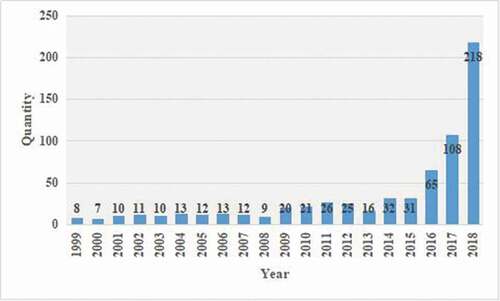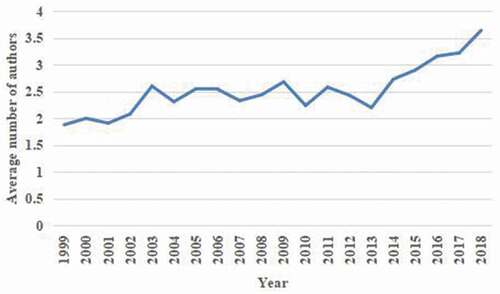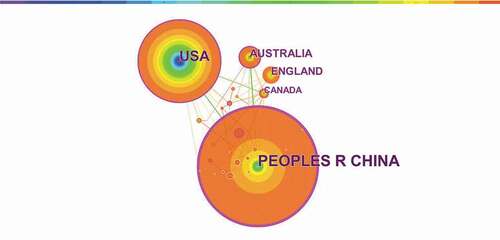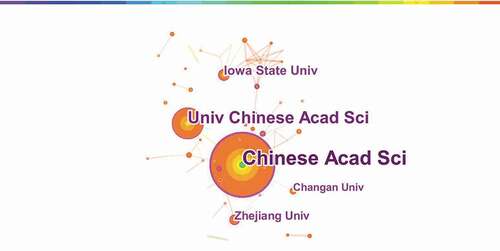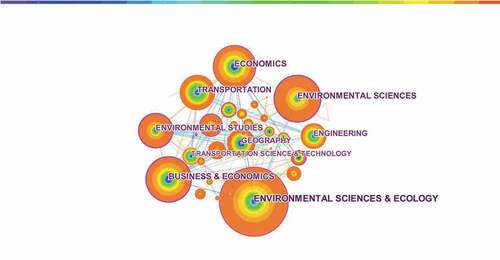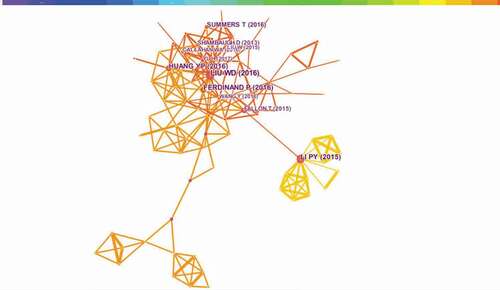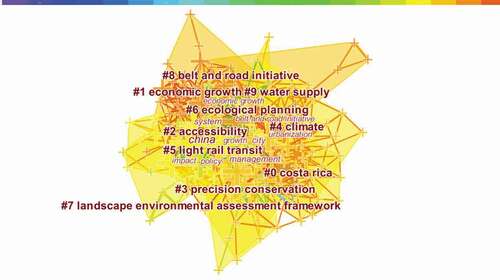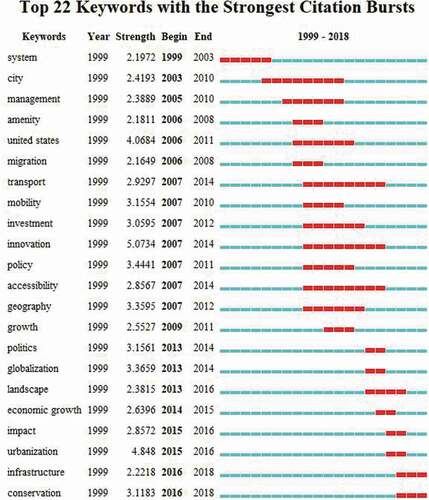ABSTRACT
The focus of this paper aims to comprehensively analyze the global high-level scientific output of economic corridors. In this study, bibliometric method is utilized not only to help identify core collaboration networks among authors, institutions, countries, but also to characterize research hotspots and research frontiers. This research has found that the number of papers dealing with economic corridors has appeared a trend of sustained growth. The most prolific country and institution are China and Chinese Academy of Science, respectively. The core of the international author cooperation community has not yet been formed. Relevant literature mainly focuses on the field of Environmental Sciences & Ecology. The hotspots include “Ecological environment protection”, “Economic development”, “Transportation”, “Resource utilization and saving” and “Belt and road initiative”. Environmental protection is a frontier subject. This finding is helpful to a comprehensive understanding of the development trend of economic corridors study.
1. Introduction
With the acceleration of the global economic integration process, the neighboring countries or regions are highly interrelated and mutually reinforcing. Regional economic and social development is facing new opportunities and challenges. Economic corridors are the manifestation of economic relations among cities, regions and countries. And it is one of the important ways to realize regional economic cooperation. Therefore, it is very necessary to understand the development situation of economic corridors in the world today, which is not only beneficial to academic research but also to government managers.
Taylor (Citation1949) thought a 100 km passageway along the Adige River, which was made up of several towns and villages, was a corridor. In the 1960s, when European countries planned urban layout, they began to expand corridors to urban areas composed of multiple towns (Hall, Citation2002). Whebell (Citation1969) carried on the systematic research to the corridor for the first time and described the corridor as a kind of linear system which connected the urban area through the traffic medium. He pointed out that the historical conditions of transport infrastructure were the important basis for the corridor formation. Corridors development can be divided into five historical stages: initial occupancy, commercial agriculture, railway transport, motor transport and metropolitanism. In 1996, the European Commission defined the “European corridor” as the “axis” formed by the cross-border movement of roads, railways, communication lines and so on between adjacent cities and regions (Zhao, Citation2006). The Asian Development Bank put forward the concept of economic corridors at the 8th Ministerial Conference on Greater Mekong Subregional Cooperation in 1998. Economic corridors were an economic cooperation mechanism which organically linked production, investment, trade with infrastructure construction at the sub-regional level. In 1999, the Council of Europe issued “European space development Perspective”, which proposed “development” should be the core element of the “European corridor” for the first time (Liu & Lu, Citation2016).
Nowadays, major developed economic corridors in the world are distributed in Europe, North America, Southeast Asia, East Asia. Europe and North America developed infrastructure on a large scale in the 1960s and 1970s, and formed a series of transportation, industrial and trade corridors (Bradbury, Citation2002; Chavas, Kim, & Lauer, Citation2001; Lee, You, & Ritchie, Citation2009; López, Monzón, Ortega, & Mancebo Quintana, Citation2009). With the slowdown of economic growth in recent years, non-physical corridors such as high and new technology, migration, trade and so on have become more prominent in North America and Europe (Pottie-Sherman, Citation2018; Witte, Van Oort, Wiegmans, & Spit, Citation2014). Since the 1980s, East Asia and Southeast Asia have developed rapidly in economic and trade, and the government has formulated strategic plans for infrastructure construction and economic development. East Asia and Southeast Asia are also concentrated area of cities, transportation, industry, trade and other corridors (Athukorala& Narayanan, Citation2018; Seo, Kim, & Kim, Citation2013). Central Asia, West Asia and other countries are rich in energy, energy transport corridors have become the main form of regional economic corridors (Dadabaev, Citation2018; Guo, Zhou, Xia, & Huang, Citation2016). In the face of the new pattern of the world economy, many countries have established national strategic economic corridors, such as China’s Belt and Road Initiative (BRI), including China–Mongolia–Russia Economic Corridor and China–Pakistan Economic Corridor, etc. (Ahmad, Mi, Keyao, Khan, & Navid, Citation2018; Rimmer, Citation2018). African economies lag behind, and economic corridors are more of a strategy and blueprint for regional governments and organizations (Du Pisanie, Citation2002; Taylor, Citation2003).
The construction of economic corridors is crucial to national development of a country. The development scale of economic corridors can be divided into urban, regional and national level. At any level, under the trend of economic globalization and regional economic integration, this is a forward-looking issue. Although the construction of economic corridors and the corresponding academic study have been actively carried out globally, there is no system research of the following questions: What countries, authors, and institutions have actively carried out economic corridors study? What journals have these research findings been published in? What are the research hotspots and trends? The purpose of this paper is to use citation analysis and visualization to draw a scientometric overview. The scientometric method can not only help us identify core collaboration networks among authors, institutions, countries, but also characterize development trends and research frontiers (He, Zhao, & Fan, Citation2019; Liang & Liu, Citation2018).
2. Materials and methods
2.1. Data source and search strategy
Literature retrieval was conducted by Social Science Citation Index (SSCI) and Science Citation Index Expanded (SCI-E) on 20 June 20 2019. In order to avoid the bias caused by the database update, all searches were done within the same day. Since many scholars also use the economic belt when describing economic corridors, the search subject words are not limited to economic corridors. Specific search strategy was as follows:
Topics = “Economic Corridor” or “Economic Belt”
Timespan = 1999–2018
Language = English
Document Types = Article
2.2. Selection criteria and data extraction
First of all, the research group carried out independent pre-retrieval and roughly browsed the title of articles in order to confirm the selection criteria of literature. The articles used to analyze the current situation and frontier of economic corridors research should meet the following criteria: (1) focus on economic corridors or economic belts; (2) contained description of industry belts, transportation corridors, development corridors and city corridors; (3) not contained description of the characteristics or formation of volcanic belts and metallogenic belts and green belts; (4) published during 1999–2018; (5) basic information could be collected. The exclusion criteria included the following: (1) duplicates; (2) articles that were irrelevant to economic corridors; (3) other document types (including reviews, book, note, etc.). Once a particular situation occurs, the research group will review the full paper and decide whether or not the paper should be included. Finally, the full bibliographic records for 667 articles were downloaded.
2.3. Research method
The progress of economic corridors over the past 20 years has been reviewed in our study through bibliometric method. In literature study, bibliometric method is used to analyze revolution of the research topic and emerging topics (Shi, Cai, & Jia, Citation2018) .
Developed by Dr. Chao Mei Chen, CiteSpace is a java application which is used for visualizing and analyzing structural and temporal patterns in scientific literature (Chen, Citation2017). CiteSpace can be used in bibliometrics to explore the research frontier along with the research trends (Li & Chen, Citation2016).
In this research, with the data from 1999 to 2018, CiteSpace 5.2.R2 is adopted to conduct visualization maps. The analysis object of CiteSpace can be divided into original literature and cited literature. Original literature is retrieved directly from the database. Cited literature is cited by the author when publishing original literature. When the object is original literature, CiteSpace can complete: (1) co-country analysis; (2) co-institution analysis; (3) co-author analysis; (4) co-category analysis; and (5) co-keyword analysis. When the object is cited literature, cited reference and cited journal analysis can be finished. The cooperative analysis of countries, institutions and authors is to reveal three different levels of scientific cooperation (macro, meso and micro). The scientific cooperation mentioned here refers to the emergence of different countries, institutions or authors in a paper at the same time, and they are considered to have a cooperative relationship. Like scientific cooperative analysis, the basic principle of co-category and co-keyword analysis also use co-word analysis, that is, a group of words appear in a paper at the same time, then this group of words form a co-occurrence relationship. Their affinity can be measured by number of co-occurrence times. Through the construction of subject association network, we can reveal the internal relationship between various disciplines. Co-keyword analysis can reflect the research hotspots in a certain field.
Co-citation analysis means that two articles appear together in the reference catalogue of a certain original literature, then the two articles form a co-citation relationship. Co-citation analysis of journals is derived from co-citation analysis of references. Co-citation analysis of references can know which articles belong to highly cited papers and which articles are more closely related. The final goal is to determine the core knowledge basis in this field. Co-citation analysis of journals provides the distribution of important sources of knowledge in a certain field, which can help to answer which journals are cited in the research in this field and what is the connection between these journals.
3. Results
3.1. A few points for clarification
The visual map generated by the CiteSpace operation is network diagram, and the node in the diagram represents different meanings because of the different analysis topics. The ring shape of nodes is the most classical display method of CiteSpace, the more occurrence frequency (or cited frequency), the larger the node. The ring of nodes represents the number of papers published (or cited) in different years. The wider the ring in a given year, the greater the frequency of papers published (cited) in the corresponding year. The change of color from cold tone to warm tone indicates the change of time from early to recent. The connection line between nodes represents a co-occurrence (or co-citation) relationship, and its thickness indicates the intensity of co-occurrence (or co-citation), and the color corresponds to the time of the first co-occurrence (or co-citation) of the nodes. It is noteworthy that the meaning of the column “Year” in many tables is same as the color of the connection line.
It is worth mentioning that nodes in the network are mainly described by two indexes: Count (i.e., frequency) and centrality. The frequency of node indicates the number of published articles by a node. For example, when analyzing a national cooperative network, the frequency of a node represents the number of articles published by a country. When analyzing cited references, the frequency represents the number of this reference cited by the original document. Centrality (i.e., intermediary centrality) is an index to measure the importance of nodes in the network. High-centrality nodes are usually key hubs to connect several different objects (such as countries, authors, categories or cited references). A node with more than 0.1 centrality in the CiteSpace is called a key node (Chen, Chen, Hu, & Wang, Citation2017).
3.2. Analysis of publication output
A total of 667 publications was took into consideration. In , a distribution of publications about economic corridors between 1999 and 2018 based on CiteSpace was presented, which split the developing process into two phases: stable development phase and rapid development phase. Firstly, it could be seen the number of articles increased steadily, from 8 in 1999 to 31 in 2015. Secondly, the quantity of publications in 2016 was twice as many as in 2015, and an accelerated increase occurred during 2016–2018.
In recent years, the number of publications related to economic corridors has appeared a trend of sustained growth as shown. This indicates that more attention has been paid to economic corridors, and more researchers have begun to involve this field. In order to find the reason for the increase in research of economic corridors since 2016, looking through 391 published articles during 2016–2018, more than half of them were related to China’s Belt and Road. Other articles discussed the Yangtze River Economic Belt, Japan’s transport corridors, Mexico’s industrial corridors and more. The Belt and Road is the abbreviation of Silk Road Economic Belt and twenty-first Century Maritime Silk Road. The Belt and Road is the important national strategic economic corridor in the whole world, and it involves 65 countries and regions. The construction of “The Belt and Road” include six corridors: China–Mongolia–Russia, New Asia–Europe Continental Bridge, China-Central Asia-West Asia, China–Indochina Peninsula, China–Pakistan and Bangladesh–China–India–Myanmar Economic Corridor.
3.3. Analysis of average number of authors
In , it showed how the average number of authors per article changed over time. With an increase from 1.88 in 1999 to 3.64 in 2018 authors per paper, a clear upward trend was visible, although the data for the following year were not always more than the previous year. It could be inferred that there were academic cooperation between the authors. Further, the author came from different institutions and countries, which provided the support for the analysis of institution and country cooperation.
3.4. Analysis of the journal distribution
In order to know which journals the 667 articles were published in, there were three procedure. The first was to check the 667 articles on the Web of Science, and the second was to add them to the “tag result list”, and last was to click “analyze search results”. The detailed results were shown in . Obviously, more articles related to economic corridors or economic belts were published in SUSTAINABILITY and TRANSPORTATION RESEARCH RECORD, but the number was not very large. It was obvious that journals were widely distributed, so it could be inferred that the construction and development of economic corridors or economic belts involved a lot of contents, and many journals were willing to accept the publication of relevant contents.
Table 1. Top 10 frequently journals
3.5. Analysis of the citation distribution of articles
presents articles with a citation frequency of more than 100. It can be found that the top five articles are all about China’s “Belt and Road Initiative”. Admittedly, six major economic corridors (including China-Mongolia-Russia, New Asia–Europe Mainland Bridge, China-Central Asia-West Asia, China–Indochina Peninsula, China–Pakistan, Bangladesh–China–India–Myanmar economic corridors) are the main construction content of the “Belt and Road Initiative” and the important framework of regional economic cooperation network.
Table 2. Top 6 articles of high citation frequency
3.6. Analysis of co-country
Data analysis showed that 667 articles were distributed in 33 countries. In , a total of 597 articles were published in the top ten countries, accounting for 89.5%. Among these countries, China published 245 articles and the United States published 177 articles, accounting for 63.3% of the total articles. Meanwhile, the node sizes of China and the United States were the first and second as shown in . This state clearly showed that China and USA attached great importance to the study of economic corridors, leading other countries in this field. According to the centrality of , China, the United States, Australia and Pakistan were in the top four. This was because Australia payed more attention to the economic development of wheat belts, and Pakistan occupied an important position in the construction of China-Pakistan Economic Corridor.
Table 3. Top 10 productive countries
3.7. Analysis of co-institution
Considering the data analysis of research institutions, the Chinese Academy of Science ranked first with 70 articles, followed by University Chinese Academy of Sciences and IOWA State University. However, the centrality rank was different from the institutions’ published volume. The top three institutions with high centrality were the Chinese Academy of Science, Zhejiang University and IOWA State University, indicating the significance of these three institutions. In the United States, IOWA State University was the main force of research. Among the top five research institutions, four came from China, emphasizing that China has made important contributions in the field of economic corridors. From another perspective, cooperation between institutions needs to be strengthened. See and for more details.
Table 4. Top 5 productive institutions
3.8. Analysis of co-author
shows the result of author collaboration analysis. Clearly, Professor Paul Tae-Woo Lee from Ocean College, Zhejiang University, China held the first place with 5 articles, followed by Professor Chuanwang Sun from Xiamen University, China with 4 articles who ranked second.
Table 5. Top 5 productive authors
Lee P T W’s main research filed was the impact of BRI on logistics industry. Sun W mainly studied the comprehensive carrying capacity of the Yangtze River Economic Belt.
Interestingly, according to the result in , all of the top 5 authors were from China, and the first year of their published papers were in 2018. This result suggests that Chinese scholars has shown more interest in the economic corridor during the past two years.
3.9. Analysis of co-category
Co-category analysis can help find the main research field of economic corridors. In CiteSpace, “Category” and top 50 levels of most occurred categories from 1-year slice were selected, the category map was obtained (). The frequency of the top 10 categories was shown in . Environmental Sciences & Ecology (191), Business & Economics (127), and Environmental Sciences (125) occupied the top 3 with the frequency. Notably, On the top 10 categories, Environmental Sciences & Ecology (191), Environmental Sciences (125) and Environmental Studies (94) connected with environment, which suggested that environment was an important research field. From a point of view of centrality, Environmental Sciences & Ecology (0.38), ranked the first place, followed by Business & Economics (0.19) and Science & Technology – Other Topics (0.18), which showed that Environmental Sciences & Ecology field played an important intermediary role in the research of economic corridors.
Table 6. Top 10 wos categories
3.10. Analysis of cited journals
Cited Journal was selected as node type. A journal cited network was obtained by running Citespace. The size of node indicated the number of the journal citation. As shown in , the larger the node, the more important the journal was. At the same time, the links of also clearly indicated that the journal in economic corridors filed connected closely. According to the results of operation, there were research findings of 287 kinds of journals published related to economic corridors. listed the top 10 frequently cited journals with more than 50 citation frequencies in this field. SCIENCE took the first place with a record of 93, followed by ECOLOGICAL ECONOMICS with citation counts of 69. The third one is NATURE, with citation counts 68. In terms of centrality, SCIENCE had the highest centrality within all journals, demonstrating a greater impact in related research. Furthermore, ENVIRONMENT AND PLANNING A-ECONOMY AND SPACE and ECOLOGICAL ECONOMICS also had a high centrality.
Table 7. Top 10 frequently cited journals
3.11. Analysis of cited references
Typically, a certain amount of references are cited in each paper. Analysis of cited references focuses on the references appended to the paper. If two references are cited together frequently, then it denotes that they are associated in some way, and network formed in this way can seize the research focus at the bottom of scientific (Chen, Hu, Liu, & Tseng, Citation2012; Yu, Citation2015). In CiteSpace, “Cited Reference” node type was selected, then cited reference map obtained as shown in .
The color of links in cited reference map represents year of first co-citation. According to , the first co-citation year of all the nodes obviously occurred after 2015. The result showed that relevant researches were mainly focused after 2015. The main articles on economic corridors were published during 2013–2017 ().
Table 8. Ranking of high frequently cited reference
In terms of the count and centrality, Liu W D (13, 0.16), Li P Y (12, 0.13) and Fallon T (7, 0.17) were top three references. Both of them were published in 2015 and 2016, and this also indirectly reflected the relevant research concentrated in recent years.
Liu and Dunford (Citation2016) paid close attention to China’s BRI, which reflected the needs of China’s own rise and included the establishment of a framework for open cooperation and new multilateral financial instruments. Li et al. (Citation2015) researched the environmental protection and sustainability under the Silk Road economic belt. Fallon (Citation2015) introduced The New Silk Road which was a grand strategy for Eurasia. This paper argued that energy, security and markets weaved together to promote trade, enhance security and aid strategic penetration. The BRI was a flexible formula without explicit deadline or clear parameters.
Apparently, the BRI proposed by China was becoming a critical bond connecting relevant research. Thus, the BRI will be still an important research topic in the future.
3.12. Analysis of co-keyword cluster
Hot topics and the research frontier can be derived from the co-keyword analysis (Xie, Citation2015). “Keyword” was chosen as the node type. By running CiteSpace, co-keyword map was obtained. CiteSpace provided the function of automatic clustering, and clicking on the button “clusters” can be achieved. The cluster label was marked by noun phrase for the clusters from indexing terms and extracted by the log-likelihood rate test method (LLR) (Chen, Ibekwe-SanJuan, & Hou, Citation2010). The co-keyword cluster map is shown in .
Research hotpots can be extracted from keyword. The detailed information of was summarized in . In , Size means the number of nodes (i.e., keywords) contained in a cluster. Silhouette (i.e., the cluster contour value) is a parameter to evaluate the cluster effect. If S > 0.5, cluster is generally considered reasonable. If S > 0.7, it means cluster is convincing. Label (LLR) means cluster name (i.e., lable) is determined by using log-likelihood rate method. Mean(Year) means average number of years in which all keywords of a cluster first appeared.
Table 9. The detailed information of clusters
Table 10. Ranking of high frequency keywords
When are taken into consideration together, the hotspots of relevant research field were revealed. According to the outcomes in the tables, five research hotpots were determined as follows:
Ecological environment protection: Cluster #0, #4, #6 and #7 were costa rica, climate, ecological planning and landscape environment assessment framework, respectively. Environmental issues have attracted increasingly attention in recent years, farmland shrinking, forest area shrinking, the deterioration of water and air pollution were not only adverse to sustainability but also threat to the survival and development of humankind. It was not surprising that ecological environment protection has become the research hotpot in the context of economic corridors construction.
Economic development: Cluster #1 was economic growth. To a certain extent, the growth of total economic volume can reflect the comprehensive strength of a region. There was no doubt that economic growth was a subject of concern to managers along the corridor area. Meanwhile, economic growth affected carbon emissions, climate change, and environmental pollution, etc.
Transportation: Cluster #2 was accessibility and Cluster #5 was light rail transit. Transportation was the infrastructure that realized connectivity within economic corridors. Many industries, such as logistics and tourism, were influenced by traffic. For example, the construction of the high-speed rail (HSR) corridor has improved accessibility, which produced positive cohesion effects at the level of corridors and nation, while balancing and polarization effects emerged at the regional level (Ortega, López, & Monzón, Citation2012).
Resource utilization and saving: Cluster #3 was precision conservation and Cluster #9 was water supply. How to achieve sustainable development under limited resources was the subject matter of scholars. Liu, Shi, and Li (Citation2018)analyzed how different types of land use promoted fair distribution by taking the Yangtze River economic belt as an example. Howard and Howard (Citation2016)discussed how to promote the sustainable management of water resources across Central Asia by means of the development of the Belt and Road.
Belt and road initiative: Cluster #8 was belt and road initiative. The BRI was put forward by Chinese President Xi in 2013. Its goal was to promote the cooperation among the countries of Europe and Asia, as well as enhancing the trust between members and unifying the market. After years of development, the BRI has become a major strategy for the common prosperity and development of the whole world.
Burst keywords analysis is conducive to chase the frontiers of related research domains. With the aid of CiteSpace, the top 22 keywords with the strongest citation bursts was created. As shown in , the blue line represented the entire period of relevant research topic (1999–2018), and the duration of the burst keywords was plotted on red line. Year represented the time when the keyword first occurred. Strength represented the degree of change in keywords, generally speaking, the greater the intensity, indicating that the change in a period of time was more obvious. Begin represented the year in which the keyword began to occur frequently, and end was the year in which the keyword ended the state of occurrence frequently.
From , the evolution of the research frontiers of economic corridors was explicit. The keywords with strongest citation bursts occurred after 2014 indicating the research frontiers in the past five years.
4. Discussion
4.1. The research status
To sum up, the research on economic corridors has gradually deepened in recent years. The number of publications progressively has increased. China could be seen as the undisputed leader in this research field and made prominent contributions in past years. Developed countries such as the United States and Australia, which have made important contributions, are the main force in this field. However, China’s research on economic corridors was later than that of the United States and Australia. By observing the collaborative networks of research countries and institutions, the most productive institutions were located in China. National cooperation networks and institutional cooperation networks had a lot in common. At the same time, from the author’s co-occurrence analysis results, China’s core author group has formed preliminarily, these scholars focused on the BRI. There was no doubt that cooperation and resource sharing should be strengthened among different institutions in different countries, so as to achieve a win-win situation. Among the published high-level literature, environmental science, economy and transportation science were the three mainstream fields. According to the map of cited journals, most of the journals were from the United States, England and the Netherlands. It could be concluded which journals paid more attention to the economic corridor, which is convenient for scholars to contribute.
4.2. Hotspots research
Combining the results of keyword co-occurrence clustering with high-frequency keywords, five research hotspots were obtained, including “Ecological environment protection”, “Economic development”, “Transportation”, “Resource utilization and saving” and “Belt and road initiative”. Obviously, in order to meet the development requirements of economic globalization and regional economic integration in recent years, the research scale of economic corridors has been extended to the international level, and its function has been constantly enriched and expanded. However, some problems were not well analyzed, such as what the process of the development of the economic corridors were? How did the transition between different development stages of economic corridors occur? And how the stability and efficiency of the management of the economic corridor were guaranteed? At present, the hotspots focused on the influence of corridors construction on regional economy, ecological environment, land space, resident living and cultural communication. For the basic logic of the economic corridor itself and the role of the economic elements, we know very little.
4.3. Frontiers research
The research frontier is constantly changing in different historical periods. According to the result of keyword citation bursts, combined with 667 literature reading, the frontiers of the economic corridor were interpreted in 5 years as a phase.
During 1999–2003, the scholars focused on the initial description of the system framework of the economic corridor. Whether the “European Corridor” referred to in the European Commission or the opinions of Asian Development Bank based on the Greater Mekong Subregion, the economic corridor was a linear system (Priemus, Citation2001; Rogerson, Citation2001), which was undisputed.
During 2004–2008, the American corn belt became a pioneer in the industrial corridor, not only increasing local economic income but also increasing jobs and improving the living standards of residents. At this stage, scholars’ research on the rust belt in the United States has also become a frontier, which was because the economy of the region rose rapidly in the early twentieth century and became a region that made remarkable achievements during the period of economic adjustment in the United States. Because of this, the revival of rust belts became an economic phenomenon that American economic circles paid close attention to and admired (Acs, Plummer, & Sutter, Citation2009).
During 2009–2013, the traffic corridors took a significant role in the formation of economic corridors. Scholars realized that solving the traffic accessibility of different geographical spaces had become the basic carrier of economic corridors development. The research on waterway corridors, highway corridors and railway corridors has become the frontier. For example, there was some research about a large road corridor in Kazakhstan. This report showed the economic impact of such a project through quantitative analysis. The quantitative work included trade facilitation, transport cost reduction, and increased productivity by using a dynamic general equilibrium model covering both direct and indirect effects. Research found the cumulative indirect impacts benefitted Kazakhstan and the many economies linked to it (Norojono, Roland-Holst, & Sugiyarto, Citation2010).
During 2014–2018, “economic growth” (2014–2015), “impact” (2015–2016), “urbanization” (2015–2016), “infrastructure” (2016–2018), and “conservation” (2016–2018) were the strongest citation bursts. Since the BRI was announced in 2013 by the Chinese government, more and more countries are joining the initiative. The core of the BRI includes to build or upgrade roads, rail lines, ports, pipelines and other infrastructure to connect China with Asia, Europe and Africa (Pardo, Citation2018). As the soul of the direct acquisition of the development paradigm, culture impact has become an important national resource base. The BRI has promoted the development of the soft power of the culture and the economic communication of the country (Yang & Yuan, Citation2018). With the deepening of the concept of sustainable development, environmental protection has become the frontiers, such as researches about the Hexi Corridor, the Yangtze economic belt, the China–Pakistan Economic Corridor, the China-Mongolia-Russia Economic Corridor and so on, including air pollution, metal pollution of soils, CO2 emission, ecosystem soil conservation, green total factor productivity and climate change (Han, Yao, Liu, & Dunford, Citation2018; Nabi, Ullah, Khan, Ahmad, & Kumar, Citation2018; Xu, Tan, Yang, & Barnett, Citation2018).
5. Conclusions
For economic globalization and regional economic integration trends, the research of economic corridors can be regarded as an attractive and emerging field for the coming years. Besides, the analysis results obtained by using CiteSpace can be observed more intuitively in comparison to the traditional literature review. In this article, the actual data of 667 articles is from the Web of Science databases and set the length of time as the most recent 20 years when exploring literature. Some interesting results have been produced. China is the absolute leader in this field, followed by the United States, Australia and the United Kingdom. Cooperation between countries and institutions is inadequate. The core of the international author cooperation community has not yet been formed. It is clear that the hotspots and the frontiers of the research in recent years are most around the BRI. In addition, environmental protection is a very prominent issue.
There are also a few limitations for this research. The data collected is only from SSCI and SCI-E when exploring literature, which may lead to bias.
Disclosure statement
No potential conflict of interest was reported by the authors.
Additional information
Funding
Notes on contributors
Can Xu
Can Xu is a full-time doctoral student in School of Civil Engineering, Central South University. She received her master’s degree in 2017.
Deming Yu
Deming Yu is a professor in School of Civil Engineering, Central South University. He specializes in engineering economics and risk management.
Hao Yang
Hao Yang and Shiyao Yu are full-time master’s degree students in School of Civil Engineering, Central South University.
References
- Acs, Z., Plummer, L. A., & Sutter, R. (2009). Penetrating the knowledge filter in “rust belt” economies. The Annals of Regional Science, 43(4), 989–1012.
- Ahmad, R., Mi, H., Keyao, R., Khan, K., & Navid, K. (2018). Aging and social security system in Pakistan: Policy challenges, opportunities, and role of China-Pakistan economic corridor (CPEC). Educational Gerontology, 44(9), 537–550.
- Athukorala, P. C., & Narayanan, S. (2018). Economic corridors and regional development: The Malaysian experience. World Development, 106, 1–14.
- Bradbury, S. L. (2002). Planning transportation corridors in post-NAFTA North America. Journal of the American Planning Association, 68(2), 137–150.
- Callahan, W. A. (2016). China’s “Asia Dream”: The Belt Road Initiative and the new regional order. Asian Journal of Comparative Politics, 1(3). doi:https://doi.org/10.1177/2057891116647806
- Chavas, J. P., Kim, K., Lauer, J. G., Klemme, R. M., & Bland, W. L. (2001). An economic analysis of corn yield, corn profitability, and risk at the edge of the corn belt. Journal of Agricultural and Resource Economics, 26(1), 230–247.
- Chen, C. M. (2017). Science mapping: A systematic review of the literature. Journal of Data and Information Science, 2(2), 1–40.
- Chen, C. M., Hu, Z. G., Liu, S. B., & Tseng, H. (2012). Emerging trends in regenerative medicine: A scientometric analysis in citespace. Expert Opinion on Biological Therapy, 12(5), 593–608.
- Chen, C. M., Ibekwe-SanJuan, F., & Hou, J. H. (2010). The structure and dynamics of cocitation clusters: A multiple-perspective cocitation analysis. Journal of the American Society for Information Science and Technology, 61(7), 1386–1409.
- Chen, Y., Chen, C. M., Hu, Z. G., & Wang, X. W. (2017). Principles and applications of analyzing a citation space. Science Press. (In Chinese)
- Dadabaev, T. (2018). The Chinese economic pivot in Central Asia and its implications for the Post-Karimov re-emergence of Uzbekistan. Asian Survey, 58(4), 747–769.
- Du Pisanie, J. A. (2002). Competition versus co-operation: The case of SADC’s regional development corridors. The South African Journal of Economics, 70(2), 310–333.
- Fallon, T. (2015). The new silk road: Xi Jinping’s grand strategy for Eurasia. American Foreign Policy Interests, 37(3), 140–147.
- Ferdinand, P. (2016). Westward ho - the China dream and ‘one belt, one road’: Chinese foreign policy under Xi Jinping. International Affairs, 92(4), 941–957
- Guo, L., Zhou, H. W., Xia, Z. Q., & Huang, F. (2016). Evolution, opportunity and challenges of transboundary water and energy problems in Central Asia. SpringerPlus, 5(1). doi:https://doi.org/10.1186/s40064-016-3616-0
- Hall, P. (2002). Urban and regional planning. Routledge.
- Han, M. Y., Yao, Q. H., Liu, W. D., & Dunford, M. (2018). Tracking embodied carbon flows in the belt and road regions. Journal of Geographical Sciences, 28(9), 1263–1274.
- He, S. Y., Zhao, Y., Fan, Y. S., Zhao, X., Yu, J., Xie, J., … Su, J. M. (2019). Research trends and hotspots analysis related to monocarboxylate transporter 1: A study based on bibliometric analysis. International Journal of Environmental Research and Public Health, 16(7), 1091.
- Howard, K. W. F., & Howard, K. K. (2016). The new “silk road economic belt” as a threat to the sustainable management of Central Asia’s transboundary water resources. Environmental Earth Sciences, 75(11). doi:https://doi.org/10.1007/s12665-016-5752-9
- Huang, Y. P. (2016). Understanding China’s Belt & Road Initiative: Motivation, framework and assessment. China Economic Review, 40, 314–321
- Lee, G., You, S., Ritchie, S. G., Saphores, J. D., Sangkapichai, M., & Jayakrishnan, R. (2009). Environmental impacts of a major freight corridor: A study of I-710 in California. Transportation Research Record, 2123(1), 119–128.
- Li, J., & Chen, C. M. (2016). Citespace: Text mining and visualization in scientific literature. 2nd Edition. Capital University of Economics and Business Press. (In Chinese)
- Li, P. Y., Qian, H., Howard, K. W. F., & Wu, J. H. (2015). Building a new and sustainable “silk road economic belt”. Environmental Earth Sciences, 74(10), 7267–7270.
- Liang, T. P., & Liu, Y. H. (2018). Research landscape of business intelligence and big data analytics: A bibliometrics study. Expert Systems with Applications, 111, 2–10.
- Liu, G., Shi, L., & Li, K. W. (2018). Equitable allocation of blue and green water footprints based on land-use types: A case study of the Yangtze river economic belt. Sustainability, 10(10). doi:https://doi.org/10.3390/su10103556
- Liu, W. D., & Dunford, M. (2016). Inclusive globalization: Unpacking China’s belt and road initiative. Area Development and Policy, 1(3), 323–340.
- Liu, Z., & Lu, G. (2016). BCIM economic corridor: Theory and practice. Social Sciences Academic Press. (In Chinese)
- López, E., Monzón, A., Ortega, E., & Mancebo Quintana, S. (2009). Assessment of cross-border spillover effects of national transport infrastructure plans: An accessibility approach. Transport Reviews, 29(4), 515–536.
- Nabi, G., Ullah, S., Khan, S., Ahmad, S., & Kumar, S. (2018). China-Pakistan economic corridor (CPEC): Melting glaciers-a potential threat to ecosystem and biodiversity. Environmental Science and Pollution Research, 25(4), 3209–3210.
- Norojono, O., Roland-Holst, D., & Sugiyarto, G. (2010). Macroeconomic effects of road corridor investment in Kazakhstan: General equilibrium perspective. Transportation Research Record, 2162(1), 90–97.
- Ortega, E., López, E., & Monzón, A. (2012). Territorial cohesion impacts of high-speed rail at different planning levels. Journal of Transport Geography, 24, 130–141.
- Pardo, R. P. (2018). Europe’s financial security and Chinese economic statecraft: The case of the belt and road initiative. Asia Europe Journal, 16(3), 237–250.
- Pottie-Sherman, Y. (2018). Austerity urbanism and the promise of immigrant-and refugee-centered urban revitalization in the US rust belt. Urban Geography, 39(3), 438–457.
- Priemus, H. (2001). Corridors in the Netherlands: Apple of discord in spatial planning. Tijdschrift Voor Economische En Sociale Geografie, 92(1), 100–107.
- Rimmer, P. J. (2018). China’s belt and road initiative: Underlying economic and international relations dimensions. Asian-Pacific Economic Literature, 32(2), 3–26.
- Rogerson, C. M. (2001). Spatial development initiatives in Southern Africa: The maputo development corridor. Tijdschrift Voor Economische En Sociale Geografie, 92(3), 324–346.
- Seo, M., Kim, A., & Kim, S. (2013). Environmental and economic impacts of transit-oriented corridors in Korea. Journal of Asian Architecture and Building Engineering, 12(2), 213–220.
- Shi, X., Cai, L. F., & Jia, J. Z. (2018). The evolution of international scientific collaboration in fuel cells during 1998–2017: A social network perspective. Sustainability, 10(12), 4790.
- Summers, T. (2016). China’s ‘New Silk Roads’: sub-national regions and networks of global political economy. Third World Quarterly, 37(9), 1628–1643
- Taylor, G. (1949). Urban geography. Methuen Publishing.
- Taylor, I. (2003). Globalization and regionalization in Africa: Reactions to attempts at neo-liberal regionalism. Review of International Political Economy, 10(2), 310–330.
- Wang, Y. (2016). Offensive for defensive: the belt and road initiative and China’s new grand strategy. The Pacific Review, 29(3), 455–463
- Whebell, C. F. J. (1969). Corridors: A theory of urban systems. Annals of the Association of American Geographers, 59(1), 1–26.
- Witte, P., Van Oort, F., Wiegmans, B., & Spit, T. (2014). European corridors as carriers of dynamic agglomeration externalities? European Planning Studies, 22(11), 2326–2350.
- Xie, P. (2015). Study of international anticancer research trends via co-word and document co-citation visualization analysis. Scientometrics, 105(1), 611–622.
- Xu, X. B., Tan, Y., Yang, G. S., & Barnett, J. (2018). China’s ambitious ecological red lines. Land Use Policy, 79, 447–451.
- Yang, C. C., & Yuan, J. H. (2018). Construction of culture soft power and a community of shared future. Revista De Cercetare Si Interventie Sociala, 63, 54–69.
- Yu, D. J. (2015). A scientometrics review on aggregation operator research. Scientometrics, 105(1), 115–133.
- Yu, H. (2017). Motivation behind China’s ‘One Belt, One Road’ Initiatives and Establishment of the Asian Infrastructure Investment Bank. Journal of Contemporary China, 26(105), 353–368
- Zhao, L. (2006). Concept and research of “corridor” in European spatial planning. Urban Planning Overseas, 21(1), (In Chinese), 59–64.


